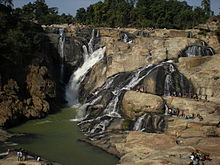The Dassam Falls (also known as Dassam Ghagh) is a waterfall located near Taimara village in Bundu police station of Ranchi district in the Indian state of Jharkhand.[1]
| Dassam Water Falls | |
|---|---|
दशम जलप्रपात | |
 Dassam Water Falls | |
 | |
| Location | Ranchi district, Jharkhand, India |
| Coordinates | 23°08′36″N 85°27′59″E / 23.143358°N 85.466441°E |
| Elevation | 336 metres (1,102 ft) |
| Total height | 44 metres (144 ft) |
| Number of drops | 2 |
| Average width | d |
| Watercourse | kanchi River |
Etymology edit
Dassam is a changed form of word Da:song which means in mundari language the act of pouring water. Da: means water and song means pouring or measuring. The water fall resembles like somebody is pouring water so the name was Da:song earlier but afterwards the name was changed to Dassam.
Geography edit
10miles
Karanpura Area
River
River
River
River
River
River
River
Dam
Falls
M: municipality, CT: census town, R: rural/ urban centre, N: neighbourhood, T: tourist centre, D: dam, H: historical/ religious centre
Owing to space constraints in the small map, the actual locations in a larger map may vary slightly
Location edit
Dassam Falls is located at 23°08′36″N 85°27′59″E / 23.143358°N 85.466441°E.
Note: The map alongside presents some of the notable locations in the district. All places marked in the map are linked in the larger full screen map.
The falls edit
The Dassam Falls is a natural cascade across the Kanchi River, a tributary of the Subarnarekha River. The water falls from a height of 44 metres (144 ft).[2] The sound of water echoes all around the place.[3] Dassam Falls at one of the edges of the Ranchi plateau is one of the many scarp falls in the region.[4]
The Dassam Falls is an example of a nick point caused by rejuvenation. Knick point, also called a nick point or simply nick, represents breaks in slopes in the longitudinal profile of a river caused by rejuvenation. The break in channel gradient allows water to fall vertically giving rise to a waterfall.[5]
The water of the Dassam Falls is very clean and clear. It is natural for a tourist to be enticed to enter the water for a bath or swim but tourists are warned not to do so because of the current that is generated. There have been many cases of drowning in Dassam Falls.[6] Nine people died of drowning between 2001 and 2006. [7]
Transport edit
The Dassam Falls is 40 kilometres (25 mi) from Ranchi on NH 33 or Ranchi-Jamshedpur highway.
External links edit
- Ranchi travel guide from Wikivoyage
- Jharkhand Tourism Attractions
See also edit
References edit
- ^ "Dassam Falls". Ranchi district administration. Archived from the original on 24 January 2010. Retrieved 24 April 2010.
- ^ "Dassam Falls". must see India. Archived from the original on 24 June 2015. Retrieved 24 April 2010.
- ^ "Dassam Falls". mapsofindia. Archived from the original on 22 June 2011. Retrieved 24 April 2010.
- ^ Bharatdwaj, K. (2006). Physical Geography: Hydrosphere By K. Bharatdwaj. Discovery Publishing House. ISBN 9788183561679. Retrieved 20 April 2010.
- ^ A.Z.Bukhari (2005). Encyclopedia of nature of geography. Anmol Publications Pvt. Limited. ISBN 9788126124435. Retrieved 11 July 2010.
{{cite book}}:|work=ignored (help)[permanent dead link] - ^ "Four drown at Dassam". Calcutta, India: The Telegraph, 21 March 2010. 21 March 2010. Archived from the original on 31 March 2010. Retrieved 24 April 2010.
- ^ "Danger warning at tourist hotspots - Death at Dasham Falls spurs statement". Calcutta, India: The Telegraph, 30 December 2006. 30 December 2006. Archived from the original on 24 October 2012. Retrieved 29 April 2010.